Jizhou Wares
The Jizhou kilns were located near Yonghe in central Jiangxi province.
Archaeological research and ancient records showed that Jizhou kilns started
production from the Late Tang/5 Dynasties period. The earliest products
consisted of white wares with a tinge of light bluish tone. The vessels
consisted mainly of ewers, dish and bowls. The bowls could be plain or have
impressed motif on the interior base. Motifs consisted of a single chinese
character such as ji (auspicious), fu (Happiness), tai ping (safety)and etc.
By early southern Song, Jizhou started
producing black wares. The glaze tends to be thin and dark chocolate or
dark brown in colour. The paste of Jizhou ware varies from a grayish white to a
light biscuit colour. The foot of the bowl is very low and hardly visible
from the front view. The early products were comparatively poor
substitutes of the thick and glossy glaze of the famous Jian black wares of
Fujian province.

The Jizhou potters were however very creative
and subsequently introduced new decorative techniques to improve on the
attractiveness of their black wares. The first technique involved a second
lighter colour over-glaze which is sprinkled, trailed or painted on the dark brownish base glaze. This new technique makesJizhou temmoku
wares distinctive and ensured its place in the history of ancient Chinese
ceramics art.

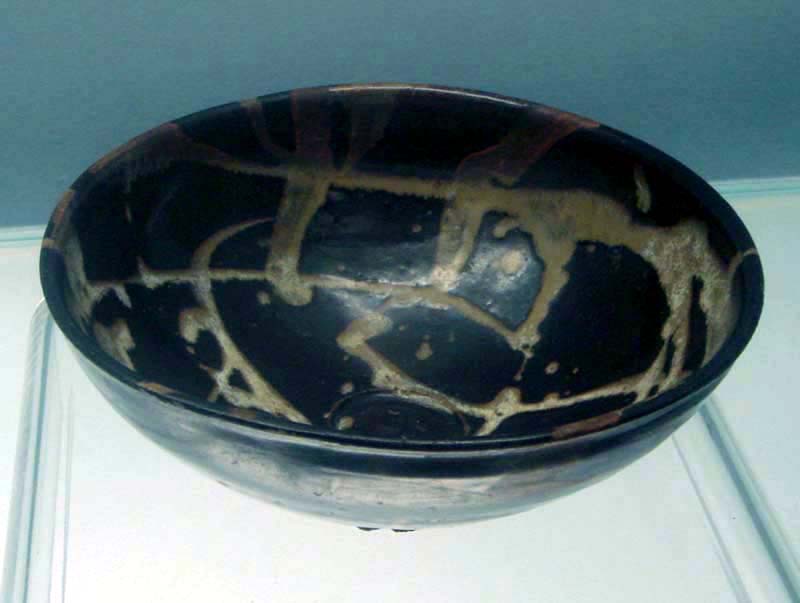
lighter over-glaze to produce the so called the tortoise shell and tiger fur
effects. They may have a dry moldy mottled quality or could be more
transparent and glossy if fired at a higher temperature.


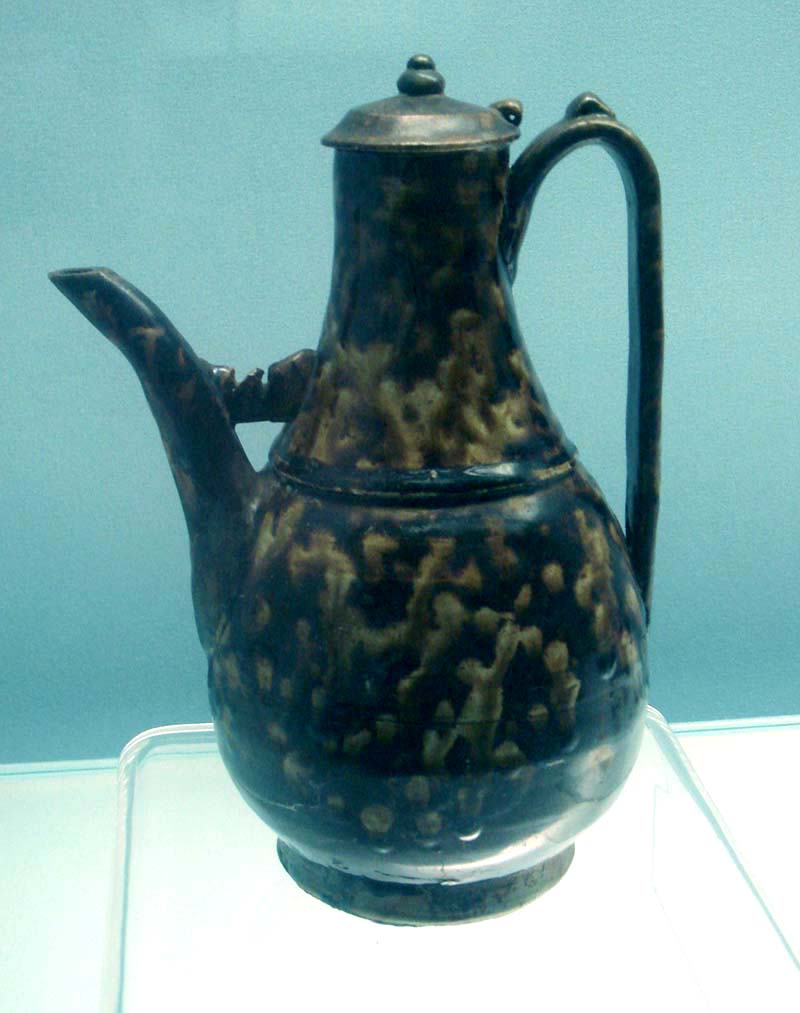
shown in below photo. According to Nigel Wood in his book "Chinese
Glazes", the composition of the recipes of the lighter colour over-glaze is
essentially similar. The results were probably the result of kiln
atmosphere and temperature. On majority of the pieces, a white milky substance
were also present especially on the area with the lighter colour glaze.
The lighter over-glaze is rich in calcia and magnesia which produced a
yellowish-milky opalescence and with further heating above 1260 degree
centigrade become a rich transparent ambers. The main ingredients in these
Jizhou over-glaze were probably wood ashes of some low-silica type.

The Jizhou potters also used paper
cuts for decorations. Usually Vessels with such decor were first coated
with a dark chocolate glaze. After which openwork stencils of cut paper
was positioned on the interior wall. A lighter glaze is then sprinkled over the whole of the interior
and sometime the external wall. After the paper shape is removed, it
showed a black design on a lighter colour mottled background. A
variation have the design in lighter colour on a black background. Some
more commonly found paper cut designs include plum blossom, floral spray, dragon,
and phoenix. There are also those with rhomboid patterns and 4 Chinese
characters such as fu shou kang ning (fortune, longevity, health and peace) or chang ming fu gui
(long life and prosperity).

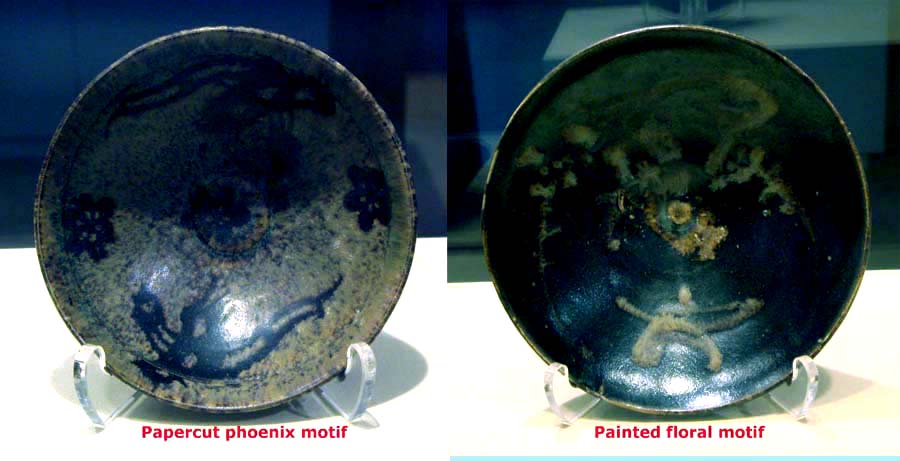
Another interesting variation is
positioning the papercut design on the vessel and then applying the dark
chocolate glaze. The design could be left unglaze or sometime the details
enhanced with iron brown slip and the whole design covered with a transparent
glaze before firing.

Another famous Jizhou black glazed ware is that
with the naturalistic leaf decoration. A pre-rotted leaf with only the
skeletal remains may have been used. Very likely, it is coated with a
lighter colour glaze before it is positioned on the interior of a black glazed
bowl.
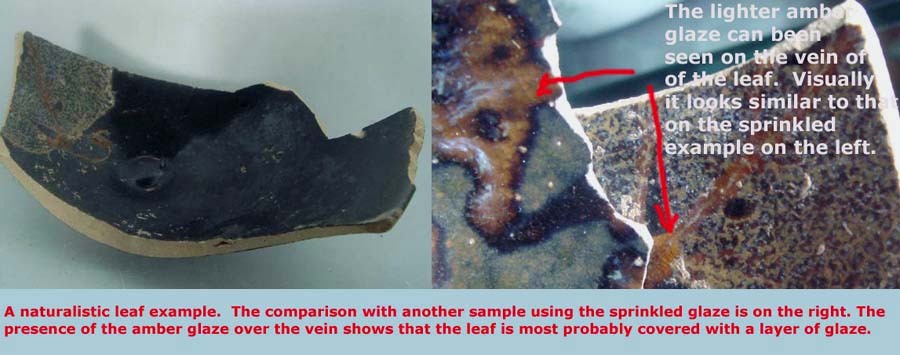
Jizhou kilns also produced Cizhou type wares
with under-glaze iron brown painted motif. In some examples, part of the
motif is incised such as the veins of the leaves on the pillow below. Thee
are also those with curved motif. The
earliest known examples of iron painted motif were from a tomb at Nanchang and
could be dated to A.D. 1209. During the Yuan period, under-glaze painted
wares became the main production of Jizhou kiln.
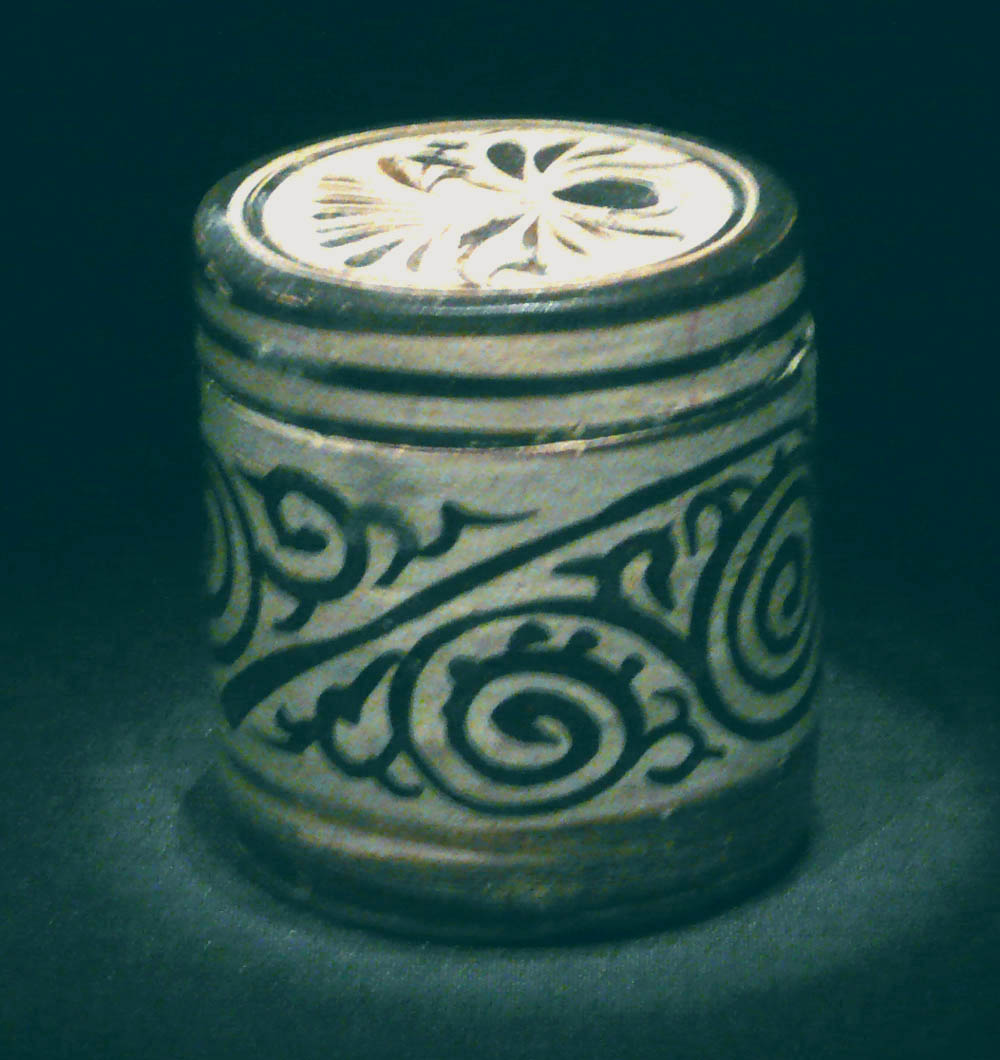
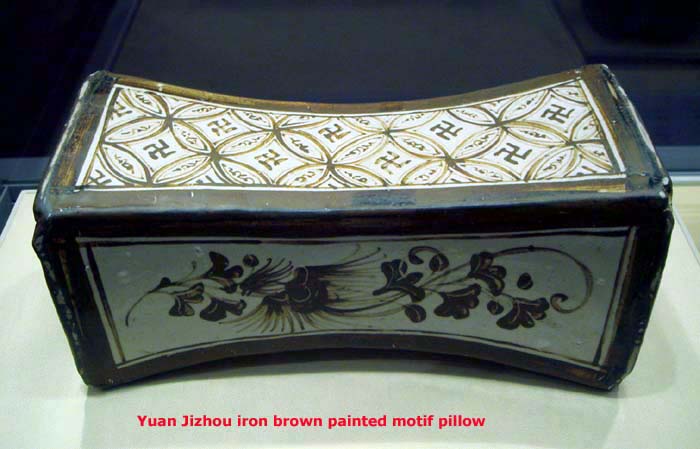
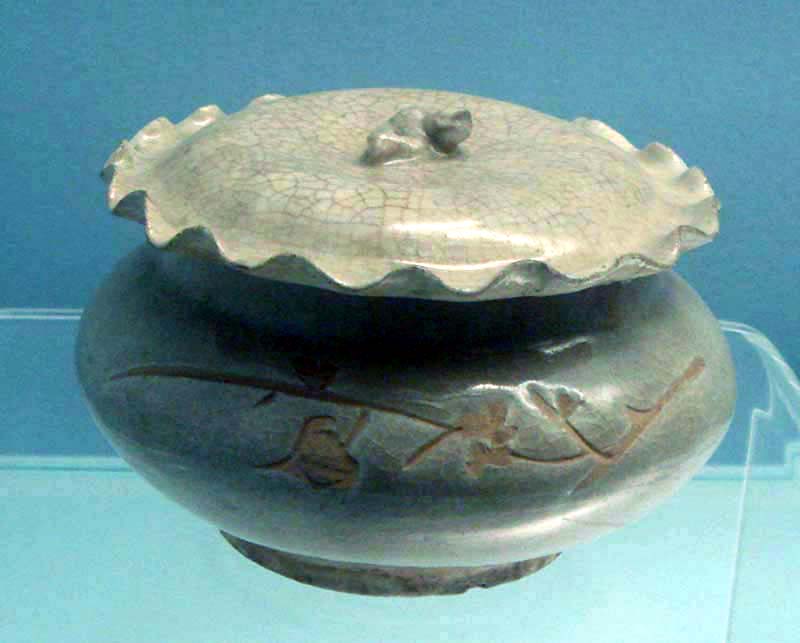
article from Chinese Antiques,
Specials price for Chinese antiques ...
Archaeological research and ancient records showed that Jizhou kilns started
production from the Late Tang/5 Dynasties period. The earliest products
consisted of white wares with a tinge of light bluish tone. The vessels
consisted mainly of ewers, dish and bowls. The bowls could be plain or have
impressed motif on the interior base. Motifs consisted of a single chinese
character such as ji (auspicious), fu (Happiness), tai ping (safety)and etc.
By early southern Song, Jizhou started
producing black wares. The glaze tends to be thin and dark chocolate or
dark brown in colour. The paste of Jizhou ware varies from a grayish white to a
light biscuit colour. The foot of the bowl is very low and hardly visible
from the front view. The early products were comparatively poor
substitutes of the thick and glossy glaze of the famous Jian black wares of
Fujian province.

The Jizhou potters were however very creative
and subsequently introduced new decorative techniques to improve on the
attractiveness of their black wares. The first technique involved a second
lighter colour over-glaze which is sprinkled, trailed or painted on the dark brownish base glaze. This new technique makesJizhou temmoku
wares distinctive and ensured its place in the history of ancient Chinese
ceramics art.


Song Jizhou bowl with white bluish suffusions in Shanghai Museum
Two well-known products involved sprinkling alighter over-glaze to produce the so called the tortoise shell and tiger fur
effects. They may have a dry moldy mottled quality or could be more
transparent and glossy if fired at a higher temperature.



Ewer in Shanghai Museum
Other types of effects were also produced asshown in below photo. According to Nigel Wood in his book "Chinese
Glazes", the composition of the recipes of the lighter colour over-glaze is
essentially similar. The results were probably the result of kiln
atmosphere and temperature. On majority of the pieces, a white milky substance
were also present especially on the area with the lighter colour glaze.
The lighter over-glaze is rich in calcia and magnesia which produced a
yellowish-milky opalescence and with further heating above 1260 degree
centigrade become a rich transparent ambers. The main ingredients in these
Jizhou over-glaze were probably wood ashes of some low-silica type.

The Jizhou potters also used paper
cuts for decorations. Usually Vessels with such decor were first coated
with a dark chocolate glaze. After which openwork stencils of cut paper
was positioned on the interior wall. A lighter glaze is then sprinkled over the whole of the interior
and sometime the external wall. After the paper shape is removed, it
showed a black design on a lighter colour mottled background. A
variation have the design in lighter colour on a black background. Some
more commonly found paper cut designs include plum blossom, floral spray, dragon,
and phoenix. There are also those with rhomboid patterns and 4 Chinese
characters such as fu shou kang ning (fortune, longevity, health and peace) or chang ming fu gui
(long life and prosperity).


Another interesting variation is
positioning the papercut design on the vessel and then applying the dark
chocolate glaze. The design could be left unglaze or sometime the details
enhanced with iron brown slip and the whole design covered with a transparent
glaze before firing.

Another famous Jizhou black glazed ware is that
with the naturalistic leaf decoration. A pre-rotted leaf with only the
skeletal remains may have been used. Very likely, it is coated with a
lighter colour glaze before it is positioned on the interior of a black glazed
bowl.

Jizhou kilns also produced Cizhou type wares
with under-glaze iron brown painted motif. In some examples, part of the
motif is incised such as the veins of the leaves on the pillow below. Thee
are also those with curved motif. The
earliest known examples of iron painted motif were from a tomb at Nanchang and
could be dated to A.D. 1209. During the Yuan period, under-glaze painted
wares became the main production of Jizhou kiln.

Yuan Jizhou iron-black painted stylised floral container in Beijing palace Museum


Jar with curved motif in Shanghai Museum
article from Chinese Antiques,
Specials price for Chinese antiques ...
Hello! Thank you so much for sharing this one. You have such an awesome post! I'll be looking forward for your other posts as well. Keep it up! This blog could really help me out with my business. Anyway, all of the designs are really one-of-a-kind and it really is worth its price. This is definitely going to be a hit for Asian art lovers. Wow! This is cool. Chinese ritual bronzes from the Shang and Western Zhou Dynasties come from a period of over a thousand years from c. 1500, and have exerted a continuing influence over Chinese art. They are cast with complex patterned and zoomorphic decoration, but avoid the human figure, unlike the huge figures only recently discovered at Sanxingdui. The spectacular Terracotta Army was assembled for the tomb of Qin Shi Huang, the first emperor of a unified China from 221–210 BCE, as a grand imperial version of the figures long placed in tombs to enable the deceased to enjoy the same lifestyle in the afterlife as when alive, replacing actual sacrifices of very early periods. Smaller figures in pottery or wood were placed in tombs for many centuries afterwards, reaching a peak of quality in the Tang Dynasty. Another important collection hails from the estate of Charles Rose Thompson in Westfield, New Jersey. Thompson’s father, Henry Rose Thompson, an importer of Asian art and antiques and co-founder of Bollentin and Thompson Oriental Rugs, acquired the artifacts during several round-the-world trips prior to and after World War I between 1900 and 1920. The items were then left to his son, Charles Rose Thompson, who was also part owner of Bollentin and Thomposn Oriental Rugs. A graduate of Princeton University, Charles lent the extraordinary collection to the Princeton University Art Museum, however the collection has remained in his family’s possession since his death in 1975. Chinese art Boston
回复删除